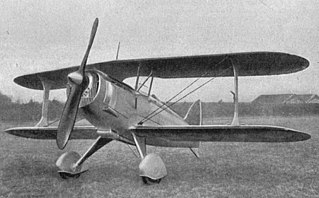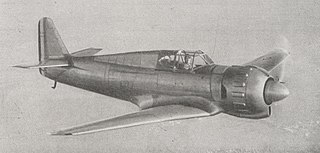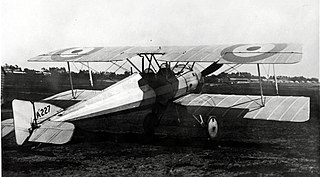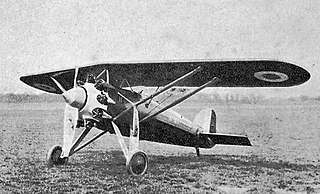
The Dewoitine D.500 was an all-metal, open-cockpit, fixed-undercarriage monoplane fighter aircraft designed and produced by French aircraft manufacturer Dewoitine.

The Morane-Saulnier M.S.406 is a French fighter aircraft developed and manufactured by Morane-Saulnier starting in 1938. It was France's most numerous fighter during the Second World War and one of only two French designs to exceed 1,000 in number. At the beginning of the war, it was one of only two French-built aircraft capable of 400 km/h (250 mph) – the other being the Potez 630.

The Hispano-Suiza 12Y was an aircraft engine produced by Hispano-Suiza for the French Air Force before the Second World War. The 12Y became the primary French 1,000 hp (750 kW) class engine and was used in a number of famous aircraft, including the Morane-Saulnier M.S.406 and Dewoitine D.520.

The Blériot SPAD S.510 was a French single-seat, single-engined biplane fighter aircraft. First flying in 1933, 60 were built for the Armée de l'Air, entering service in 1936. The type remained in service as a fighter-trainer at the start of the Second World War. It was the last French biplane fighter to enter production.

The Bloch MB.150 was a French fighter aircraft developed and produced by Société des Avions Marcel Bloch. It featured an all-metal construction, complete with a retractable undercarriage, low cantilever wing and a fully enclosed cockpit.

The Morane-Saulnier N, also known as the Morane-Saulnier Type N, was a French monoplane fighter aircraft of the First World War. Designed and manufactured by Morane-Saulnier, the Type N entered service in April 1915 with the Aéronautique Militaire designated as the MoS-5 C1. It also equipped four squadrons of the Royal Flying Corps, in which it was nicknamed the Bullet, and was operated in limited numbers by the 19th Squadron of the Imperial Russian Air Force.

The Koolhoven F.K.58 was a single engine, interceptor-fighter aircraft designed and mainly manufactured by N V Koolhoven in the Netherlands under contract by France. Intended for Armée de l'Air use, the F.K.58 saw limited service in the Battle of France.

The Rogožarski IK-3 was a 1930s Yugoslav monoplane single-seat fighter, designed by Ljubomir Ilić, Kosta Sivčev and Slobodan Zrnić as a successor to the Ikarus IK-2 fighter. Its armament consisted of a hub-firing 20 mm (0.79 in) autocannon and two fuselage-mounted synchronised machine guns. It was considered comparable to foreign aircraft such as the Messerschmitt Bf 109E and came into service in 1940. The prototype crashed during testing; twelve production aircraft had been delivered by July 1940.

The Morane-Saulnier M.S.225 was a French fighter aircraft of the 1930s. It was produced in limited quantities to be used as a transitional aircraft between the last of the biplanes and the first monoplane fighters.

The Morane-Saulnier MS.230 aircraft was the main elementary trainer for the French Armée de l'Air throughout the 1930s. Almost all French pilots flying for the Armée de l'Air at the outbreak of World War II had had their earliest flight training in this machine. It was the equivalent of the Stearman trainer in the United States air services and the de Havilland Tiger Moth in the British Royal Air Force.

The Morane-Saulnier Vanneau is a two-seat basic trainer built in France by Morane-Saulnier and ordered by the French Air Force.

The Morane-Saulnier MoS-121, also known as the Morane-Saulnier MS.121 was a French fighter prototype of the 1920s. It was Morane-Saulnier's first fighter design after World War I.

The Morane-Saulnier BB was a military observation aircraft produced in France during World War I for use by Britain's Royal Flying Corps. It was a conventional single-bay biplane design with seating for the pilot and observer in tandem, open cockpits. The original order called for 150 aircraft powered by 110-hp Le Rhône 9J rotary engines, but shortages meant that most of the 94 aircraft eventually built were delivered with 80 hp Le Rhône 9C rotaries instead. A water-cooled Hispano-Suiza 8A engine was trialled as an alternative in the Type BH, but this remained experimental only. A production licence was sold to the Spanish company Compañía Española de Construcciones Aeronáuticas (CECA), which built twelve fitted with Hispano-Suiza engines in 1916.

The Morane-Saulnier MS.755 Fleuret was a prototype French two-seat jet trainer designed and built by Morane-Saulnier. It failed to gain any orders but was developed into the larger four-seat MS.760 Paris.

The SNCAO 200, sometimes written CAO.200, was a prototype French single seat fighter aircraft of the 1930s. It was a single engined monoplane intended to compete with the Dewoitine D.520, but was unsuccessful, only a single example being built.

The Loire 250 was a French single-seat fighter monoplane designed and built by Loire Aviation of St. Nazaire.
The Bernard 260 C1 was a French all-metal, single-engine, low-wing monoplane with an open cockpit and fixed undercarriage, designed to a government single-seat fighter specification issued in 1930. After extensive comparative tests the Dewoitine D.500 was ordered in preference, though the performances of the two aircraft were similar.

The Loire-Nieuport 161 was a single-seat, single-engine, all-metal, low-wing monoplane fighter designed and built in France in 1935 to compete for a government contract. Accidents delayed its development and only three prototypes were completed.

The Hanriot H.110 was an unusual pusher configuration, twin boom, single seat fighter aircraft built in France in the early 1930s. It proved to be slower and less manoeuvrable than its contemporaries and failed to reach production, even as the Hanriot H.115 after receiving a more powerful engine and cannon armament.

The Morane-Saulnier MS.224 was a prototype fighter plane built by Morane-Saulnier in the early 1930s.




















